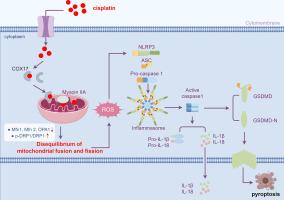Cisplatin transported by COX17 induces cochlear damage by binding Myosin IIA to regulate cell pyroptosis induced by mitochondrial dysfunction
IF 5.1
2区 医学
Q1 MEDICINE, RESEARCH & EXPERIMENTAL
引用次数: 0
Abstract
Aims
Cytochrome c oxidase copper chaperone 17 (COX17) could transport cisplatin to cancer cell mitochondria. Whether COX17 transports cisplatin to cochlear mitochondria and induces pyroptosis to participate in cisplatin-induced ototoxicity remains unknown.
Materials and methods
A cisplatin-induced hearing loss model was constructed in rats, and the role of COX17 and Myosin IIA in cisplatin-induced hearing loss and cochlear injury was evaluated by auditory brainstem response test and H&E staining. Cisplatin binding to Myosin IIA was verified through cisplatin agar-pull-down assays and drug affinity responsiveness target stability. The interaction between Myosin IIA and F-actin was verified using co-immunoprecipitation. Various techniques were used to study how cisplatin causes damage to cochlear hair cells and induces pyroptosis, including immunofluorescence staining, and flow cytometry.
Key findings
Our findings indicated that downregulating COX17 inhibits cisplatin accumulation in mitochondria, leading to improved cell survival, and inhibits pyrodeath. Upon entering the mitochondria, cisplatin transported by COX17 binds to Myosin IIA, enhancing its expression and subsequently promoting the expression of F-actin and p-DRP1 while inhibiting the expression of Mfn1, Mfn2, and OPA1. Furthermore, the interaction between Myosin IIA and F-actin was determined. Downregulation of Myosin IIA or treatment with mitochondrial fission inhibitors resulted in reduced mitochondrial ROS release and increased pyroptosis. In vivo studies demonstrated that downregulating COX17 or Myosin IIA improved cisplatin-induced hearing loss and cochlear damage in rats.
Significance
These findings offer new insights and potential targets for the preventing and treatment of cisplatin-induced ototoxicity.

COX17转运顺铂通过结合Myosin IIA调节线粒体功能障碍诱导的细胞焦亡,诱导耳蜗损伤。
目的:细胞色素c氧化酶铜伴侣蛋白17 (COX17)可将顺铂转运至癌细胞线粒体。COX17是否将顺铂转运到耳蜗线粒体并诱导焦亡参与顺铂诱导的耳毒性尚不清楚。材料与方法:建立大鼠顺铂性听力损失模型,通过听觉脑干反应试验和H&E染色评价COX17和Myosin IIA在顺铂性听力损失和耳蜗损伤中的作用。通过顺铂琼脂下拉实验和药物亲和反应性靶标稳定性验证顺铂与Myosin IIA的结合。用共免疫沉淀法验证Myosin IIA和F-actin之间的相互作用。使用多种技术研究顺铂对耳蜗毛细胞的损伤和诱导焦亡,包括免疫荧光染色和流式细胞术。主要发现:我们的研究结果表明,下调COX17抑制顺铂在线粒体中的积累,导致细胞存活改善,并抑制焦性死亡。顺铂经COX17转运进入线粒体后,与Myosin IIA结合,增强其表达,进而促进F-actin和p-DRP1的表达,抑制Mfn1、Mfn2和OPA1的表达。进一步测定了Myosin IIA与F-actin的相互作用。下调Myosin IIA或用线粒体裂变抑制剂治疗导致线粒体ROS释放减少和焦亡增加。体内研究表明,下调COX17或Myosin IIA可改善顺铂诱导的大鼠听力损失和耳蜗损伤。意义:这些发现为预防和治疗顺铂所致耳毒性提供了新的见解和潜在靶点。
本文章由计算机程序翻译,如有差异,请以英文原文为准。
求助全文
约1分钟内获得全文
求助全文
来源期刊

Life sciences
医学-药学
CiteScore
12.20
自引率
1.60%
发文量
841
审稿时长
6 months
期刊介绍:
Life Sciences is an international journal publishing articles that emphasize the molecular, cellular, and functional basis of therapy. The journal emphasizes the understanding of mechanism that is relevant to all aspects of human disease and translation to patients. All articles are rigorously reviewed.
The Journal favors publication of full-length papers where modern scientific technologies are used to explain molecular, cellular and physiological mechanisms. Articles that merely report observations are rarely accepted. Recommendations from the Declaration of Helsinki or NIH guidelines for care and use of laboratory animals must be adhered to. Articles should be written at a level accessible to readers who are non-specialists in the topic of the article themselves, but who are interested in the research. The Journal welcomes reviews on topics of wide interest to investigators in the life sciences. We particularly encourage submission of brief, focused reviews containing high-quality artwork and require the use of mechanistic summary diagrams.
 求助内容:
求助内容: 应助结果提醒方式:
应助结果提醒方式:


